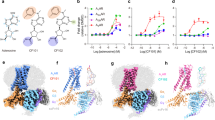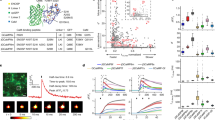Abstract
PLATELET aggregation and secretion are widely studied not only because they are believed to reflect the major in vivo platelet function, formation of the primary haemostatic plug, but also because they involve fundamental cellular regulatory mechanisms. The synthesis of biologically active prostaglandin (PG) intermediates (endoperoxides and thromboxanes) seems to be an important step in the regulation of platelet function1,2, but the physiological roles and mechanism(s) of these compounds are unknown. It is claimed by Malmsten et al.3 and Samuelsson et. al.4 that PG endoperoxides and thromboxane A2 cause platelet aggregation only by inducing platelets to secrete ADP that in turn causes aggregation. In view of observations that platelets deficient in releasable ADP (storage pool-deficient platelets or platelets depleted of storage granules) still aggregate in response to arachidonic acid5–7, the precursor of the intermediates, the validity of this claim has been open to question. We have investigated platelet stimulation by PG endoperoxides (PGG2 and PGH2), an endoperoxide analogue ((15S)-hydroxy-11α, 9α-(epoxymethano) prosta-5Z, 13E-dienoic acid; U-46619), thromboxane A2-like material and arachidonic acid, using a new instrument that simultaneously monitors aggregation and secretion in the same platelet suspension8, permitting careful analysis of the relationships between aggregation and secretion. We report here that although high concentrations of the endoperoxide analogue, the natural endoperoxides and thromboxane A2 induce both platelet aggregation and secretion, low concentrations cause aggregation without detectable secretion.
This is a preview of subscription content, access via your institution
Access options
Subscribe to this journal
Receive 51 print issues and online access
$199.00 per year
only $3.90 per issue
Buy this article
- Purchase on Springer Link
- Instant access to full article PDF
Prices may be subject to local taxes which are calculated during checkout
Similar content being viewed by others
References
Hamberg, M., Svensson, J., Wakabeyashi, T. & Samuelsson, B. Proc. natn. Acad. Sci. U.S.A. 71, 345 (1974).
Hamberg, M., Svensson, J. & Samuelsson, B. Proc. natn. Acad. Sci. U.S.A. 72, 2994 (1975).
Malmsten, C., Hamberg, M., Svensson, J. & Samuelsson, B. Proc. natn. Acad. Sci. U.S.A. 72, 1446 (1975).
Samuelsson, B., Hamberg, M., Malmsten, C. & Svensson, J. in Advances in Prostaglandin and Thromboxane Research 2 (eds Samuelsson, B. & Paoletti, R.) 737 (Raven, New York, 1976).
Kinlough-Rathbone, R. L., Reimers, H. J., Mustard, J. F. & Packham, M. A. Science 192, 1011 (1976).
Smith, J. B., Ingerman, C. M. & Silver, M. J. in Advances in Prostaglandin and Thromboxane Research 2 (eds Samuelsson, B. & Paoletti, R.) 747 (Raven, New York, 1976).
Weiss, H. J., Willis, A. L., Kuhn, D. & Brand, H. Br. J. Haemat. 32, 257 (1976).
Feinman, R. D., Lubowsky, J., Charo, I. & Zabinski, M. J. lab. clin. Med. 90, 125 (1977).
Detwiler, T. C. & Feinman, R. D. Biochemistry 12, 2462 (1973).
Charo, I. F., Lubowsky, J., Feinman, R. D. & Detwiler, T. C. in Platelet Function-Testing (eds Day, H. J., Holmsen, H. & Zucker, U. B.) (DHEW-Publ.-NTH-77–108, US Government Printing Office, Bethesda, in the press).
Nugteren, D. H. & Hazelhof, E. Biochim. biophys. Acta 326, 448 (1973).
Chignard, M. & Vargaftig, B. B. Eur. J. Pharmac. 38, 7 (1976).
Smith, J. B., Ingerman, C. & Silver, M. J. J. clin. Invest. 58, 1119 (1976).
Smith, J. B. & Macfarlane, D. E. in The Prostaglandins 2 (ed. Ramwell, P. W.) 293 (Plenum, New York, 1974).
Charo, I. F., Feinman, R. D. & Detwiler, T. C. J. clin. Invest. (in the press).
Malmsten, C. Life Sci. 18, 169 (1976).
Corey, E. J., Nicolaou, K. C., Yoshimasa, M., Malmsten, C. L. & Samuelsson, B. Proc. natn. Acad. Sci. U.S.A. 72, 3355 (1975).
Silver, M. J., Smith, J. B., Ingerman, C. & Kocsis, J. J. Prostaglandins 4, 864 (1973).
Holmsen, H., Day, H. J. & Setkowsky, C. A. Biochem. J. 129, 67 (1972).
Mills, D. C. B., Robb, I. A. & Roberts, G. C. K. J. Physiol., Lond. 195, 715 (1968).
DeLuca, M. & McElroy, W. D. Biochemistry 13, 921 (1974).
Lundin, A., Rickardsson, A. & Thore, A. Analyt. Biochem. 75, 611 (1976).
Author information
Authors and Affiliations
Rights and permissions
About this article
Cite this article
CHARO, I., FEINMAN, R., DETWILER, T. et al. Prostaglandin endoperoxides and thromboxane A2 can induce platelet aggregation in the absence of secretion. Nature 269, 66–69 (1977). https://doi.org/10.1038/269066a0
Received:
Accepted:
Issue Date:
DOI: https://doi.org/10.1038/269066a0
This article is cited by
-
Effects of Post-translational Modifications on Membrane Localization and Signaling of Prostanoid GPCR–G Protein Complexes and the Role of Hypoxia
The Journal of Membrane Biology (2019)
-
The effect of borage oil consumption on the composition of individual phospholipids in human platelets
Lipids (1992)
-
Synergistic platelet activation by aggregates of IgG and the phospholipid platelet-activating factor 1-O-alkyl-2-acetyl-SN-glycero-3-phosphorylcholine
Journal of Clinical Immunology (1986)
Comments
By submitting a comment you agree to abide by our Terms and Community Guidelines. If you find something abusive or that does not comply with our terms or guidelines please flag it as inappropriate.



